Standard [CURRENT]
ASTM D 3874:2020
Standard Test Method for Ignition of Materials by Hot Wire Sources
- German title
- Prüfung der Zündfähigkeit von Werkstoffen durch Glühdrähte
- Publication date
- 2020
- Original language
- English
- Pages
- 6
- Publication date
- 2020
- Original language
- English
- Pages
- 6
- DOI
- https://dx.doi.org/10.1520/D3874-20
Product information on this site:
Quick delivery via download or delivery service
Buy securely with a credit card or pay upon receipt of invoice
All transactions are encrypted
Short description
1.1 This test method is intended to differentiate, in a preliminary fashion, among materials with respect to their resistance to ignition because of their proximity to electrically-heated wires and other heat sources. 2 1.2 This test method applies to molded or sheet materials available in thicknesses up to and including 13.0 mm (0.51in.). 1.3 This test method applies to materials that are rigid or flexible at normal room temperatures. It is important to minimize deformation during preparation, especially during the wire-wrapping step described in 10.1 , by following the method outlined under Clause 10, Sample Preparation. Examples of deformation include bowing, in either a transverse or a longitudinal direction, twisting of the specimen, and indentation of the wire into the specimen during the wire-wrapping step, to a degree visible to the eye. 1.4 The values stated in SI units are to be regarded as standard. The values given in parentheses after SI units are provided for information only and are not considered standard. (See SI10 for further details.) 1.5 This test method measures and describes the response of materials, products, or assemblies to heat and flame under controlled conditions, but does not by itself incorporate all factors required for fire hazard or fire risk assessment of the materials, products, or assemblies under actual fire conditions. 1.6 This standard does not purport to address all of the safety concerns, if any, associated with its use. It is the responsibility of the user of this standard to establish appropriate safety, health, and environmental practices and determine the applicability of regulatory limitations prior to use. 1.7 Fire testing is inherently hazardous. Adequate safeguards for personnel and property shall be employed in conducting these tests. Note 1: Although this test method and IEC TS 60695-2-20 (withdrawn) differ in approach and in detail, data obtained using either are technically equivalent. 1.8 This international standard was developed in accordance with internationally recognized principles on standardization established in the Decision on Principles for the Development of International Standards, Guides and Recommendations issued by the World Trade Organization Technical Barriers to Trade (TBT) Committee.
ICS
13.220.40,
29.035.01
DOI
https://dx.doi.org/10.1520/D3874-20
Also available in
Loading recommended items...
Loading recommended items...
Loading recommended items...
Loading recommended items...

